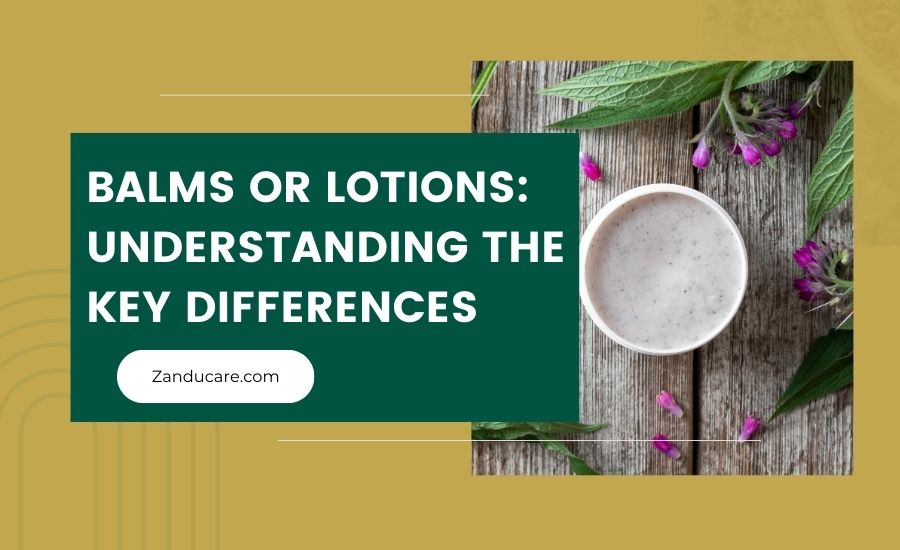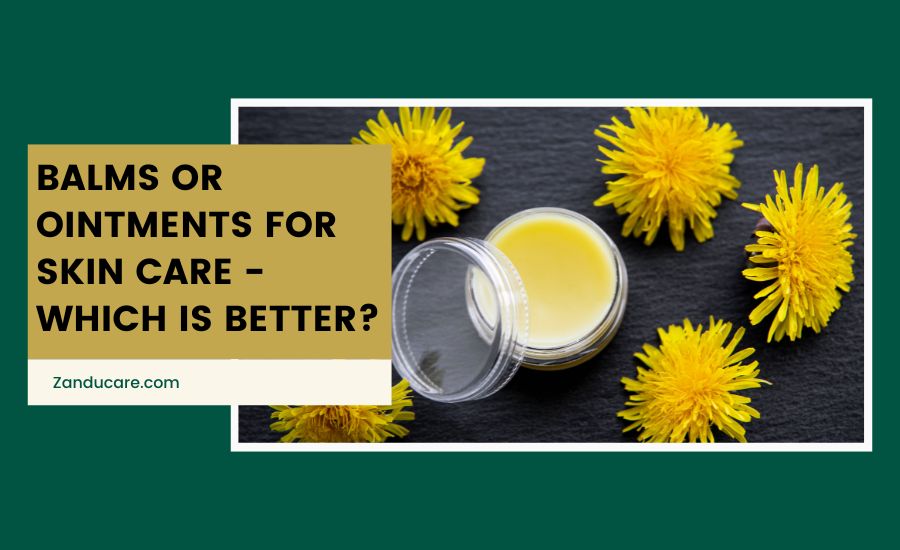
Balms Vs Lotions: Key Differences in Benefits and Effects
|
Key Insights:
|
When moisturising your skin, you can choose between creams, lotions, and balms. Deciding between a balm or lotion can be confusing, as they have different ingredients and textures. If you have found yourself undecided between choosing a balm or lotion for your skincare routine, understanding the key distinctions can help you pick the best choice for nourishing your unique skin type.
When determining if a balm or a lotion is right for your needs, you should consider factors like your specific skin type, the moisture level your skin needs, and what parts of your body you aim to treat. Read on to learn more about how balms and lotions are unique in their properties and uses.
|
Did you know:
|
Balm vs Lotion
|
Aspect |
Balm |
Lotion |
|
Texture |
Thick, dense, and more solid |
Light, smooth, and fluid |
|
Consistency |
Waxy and oily, often semi-solid |
Watery or creamy, easily spreadable |
|
Main Ingredients |
High in oils, waxes, and butter |
Water-based with light oils and emulsifiers |
|
Absorption Rate |
Slow, sits on the skin for longer periods |
Quick, absorbs rapidly |
|
Moisturising Level |
Deeply hydrating, forms a protective barrier |
Hydrating but lighter than balm |
|
Usage Areas |
Targeted areas with very dry skin (e.g., elbows, knees) |
Whole-body application, including face |
|
Purpose |
Provides intense moisture for rough, cracked skin |
General hydration, suitable for daily use |
|
Skin Types |
Best for very dry or damaged skin |
Suitable for all skin types |
|
Greasy Feel |
Leaves a more noticeable oily feel |
Less greasy, more lightweight feel |
|
Best for |
Extreme dryness, eczema, sensitive areas |
Regular hydration, maintaining skin softness |
|
Application Time |
Applied in small amounts to specific areas |
Applied generously over larger areas |
What is Lotion?

Lotions have a lightweight, fluid texture that spreads easily over large areas of skin. The main reason lotions glide smoothly over the skin is their high water content. Lotions are made by blending oil and water with an emulsifying agent to keep them mixed. However, unlike creams or balms, lotions contain higher amounts of water than oil in their recipe. Typically, lotions are around 70-80% water. This gives them a lighter, less greasy feel than richer balms or creams.
The oils and other ingredients in lotions help moisturise the upper layers of the skin and supply nutrients to keep it healthy. The low oil and high water content allow lotions to absorb rapidly into the skin. This makes lotions a popular choice as easy-to-apply moisturisers for the body and face—especially useful for people with acne-prone skin who want good hydration without heaviness or clogged pores.
Benefits of Using Lotions

Lotions are incredibly versatile, making them a staple for daily skincare routines. Here’s what makes them stand out:
- Quick Absorption: Thanks to their water-based formulation, lotions are designed to sink into the skin quickly. This makes them perfect for those on the go who want a non-greasy moisturiser. Lotions are light and do not leave an oily residue, which is especially helpful for people with normal to oily skin who want hydration without a heavy feel.
- All-Over Hydration: Lotions are meant for full-body use and can be spread easily over larger surface areas. This makes them ideal for general hydration, ensuring the skin remains soft and supple. Applying lotion after a shower is a quick way to lock in moisture for the entire day.
- Suitable for All Skin Types: Because they are less greasy and more breathable, lotions can cater to almost every skin type. A lotion provides the necessary moisture without clogging pores for those with oily or combination skin. They’re also gentle enough for sensitive skin, provided they’re free of irritants like fragrances or alcohol.
What is Balm?

Balms have an oil-based formula that contains waxes and butter but little to no water content. This gives balms a thick, dense texture that is very moisturising. Unlike lotions, which blend oil and water, balms are considered "water-in-oil" mixtures - meaning the oil is the dominant ingredient. Common oils in balms are plant-based, like coconut, almond, or olive oil. Balms also contain waxes like beeswax or shea butter, which form the formula into a salve-like balm that adheres well to the skin. The wax and oils lock moisture into the skin while supplying nourishing vitamins and fatty acids.
This makes balms excellent for extremely dry areas prone to cracking, such as hands, heels, elbows, or knees. However, the rich formula may be too heavy for delicate facial skin. But for severely dehydrated areas, balms can provide protective, intensive hydration without a water component—just using the power of plant oils, butters, and waxes.
Benefits of Using Balms
Balms are designed with specific skin needs, and their benefits are most effective for particular skin conditions or areas. Here’s why they’re worth considering:
- Deep Hydration: Balms are packed with oils and waxes, forming a protective barrier on the skin that keeps moisture locked in. This barrier helps prevent transepidermal water loss, especially for people with extremely dry skin. The oils used in balms, like jojoba or coconut oil, deeply moisturise and penetrate the skin slowly, providing prolonged hydration.
- Targeted Relief: Balms are especially useful for specific areas of the body that need intense hydration. Unlike lotions, which are typically applied all over, balms work best when used on localised spots. Think of rough, cracked skin on elbows, knees, or hands—areas that face more environmental stress or friction. For those suffering from eczema or psoriasis, balms are often more effective because they provide a longer-lasting shield over the skin.
- Long-Lasting Protection: Because of their thick consistency, balms stay on the skin longer. This is beneficial for individuals who need long-term hydration without frequent reapplication. The waxy, semi-solid nature of balms allows them to stick around, offering a protective layer even during harsh weather, which can be crucial for preventing chapped skin in winter.
How to Choose Between a Balm and a Lotion
When selecting a moisturiser for your skin, deciding between a balm or a lotion depends on a few key factors:
- Skin Type: Consider if your skin tends to be oily, dry or normal. Balms provide very rich hydration best suited to extremely dry skin that needs extra moisture. Lotions offer lighter hydration that may be enough for normal or slightly dry skin. Oily skin may prefer a lotion to avoid clogged pores.
- Areas to Treat: Balms are ideal for small, localised dry areas like hands, lips, elbows, etc., while lotions effectively cover large areas like the face and body.
- Level of Hydration Needed: Balms provide an intense, occlusive layer of hydration by trapping moisture. Lotions deliver lighter hydration, mainly to the upper layers of skin. Very dehydrated skin benefits more from a thick, protective balm.
- Preference for Texture: The texture difference mainly comes from balms having more oils/butters vs lotions which use more water. If you dislike thick, greasy products a lotion may suit you better. Some may find balms too heavy.
- Environment: In cold, windy climates, balms create a protective layer to prevent moisture loss from dry air. Lotions may not have an occlusive enough barrier. In hot, humid environments, lighter lotions can be more comfortable.
- Purpose: If you need intensive lip treatment, for example, a lip balm provides concentrated care. A body lotion glides over your body easily to moisturise without heaviness.
Also, do check our related guide:
Conclusion
A balm can provide a thick, ultra-hydrating formula if your skin is severely dehydrated. On the other hand, for skin that doesn't require heavy moisturisation, a lotion may offer plenty of lightweight hydration. Consider where you will use the product and your skin’s needs. A balm is excellent for localised treatment of dry patches, while a hydrating lotion works well for large areas like the face and body without heaviness. Understanding the differences between formulated balms and lotions can help you pick the best moisturising product for nurturing your skin.
FAQs
1. Can I use a balm on my face, or is it too heavy?
Yes, balms can be used on the face, but they’re best for very dry or damaged skin, especially in areas prone to dehydration, like around the nose or lips. People with oily or acne-prone skin may find balms too heavy, as they can clog pores. Using balms on specific dry spots is ideal, while lotion works better as an all-over facial moisturiser for lighter hydration.
2. Which is better for winter, balm or lotion?
Balms are generally better suited for winter because they create a moisture-locking barrier, which helps protect skin from harsh, cold air and low humidity. Their thick texture prevents moisture loss, making them ideal for preventing chapped skin. Lotions can be used for general body hydration in winter, but they might not provide the intense protection that balms do for areas like hands and heels.
3. Is it okay to layer a lotion over a balm or vice versa?
Yes, layering can be very effective for extra hydration. Applying balm first helps lock in moisture, and a lotion over it can add further hydration. Alternatively, you can apply lotion first for immediate moisture, then add balm to seal in the hydration, which is particularly useful for very dry or rough areas, such as elbows and knees.
4. How do I know if my skin needs a balm or a lotion?
Choose a balm if your skin is very dry, cracked, or needs intensive care—balms are ideal for deeply hydrating rough patches. If you have normal or slightly dry skin, a lotion provides balanced hydration and is easier to spread over large areas. Additionally, oily or acne-prone skin types do better with lotions due to their lighter, non-comedogenic formula.
5. Can balms help with skin conditions like eczema or psoriasis?
Yes, balms can benefit eczema or psoriasis, providing a thick, moisture-retaining barrier that soothes and protects sensitive skin. The high oil content in balms helps reduce itching and flakiness, common symptoms of these conditions. However, choosing a balm free of fragrances and allergens is essential, as these can irritate sensitive skin further.
References:
- Lotion, a liquid skincare product, primarily offers emollient and soothing effects, enhancing skin softness and delivering a beautifying touch. (https://www.researchgate.net/)
- Lotions are ideal, lightweight moisturisers for the body and face, perfect for acne-prone skin seeking hydration without heaviness or pore clogging. (https://www.researchgate.net/)
- With a water-based formula, lotions are crafted to absorb swiftly into the skin for quick, effective hydration. (https://www.researchgate.net/)





